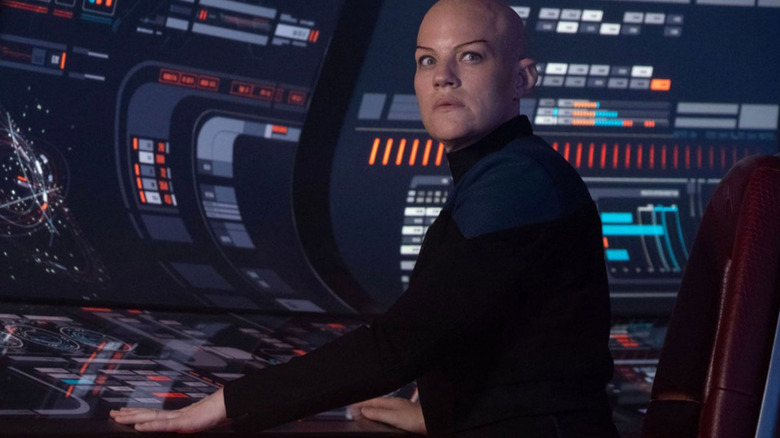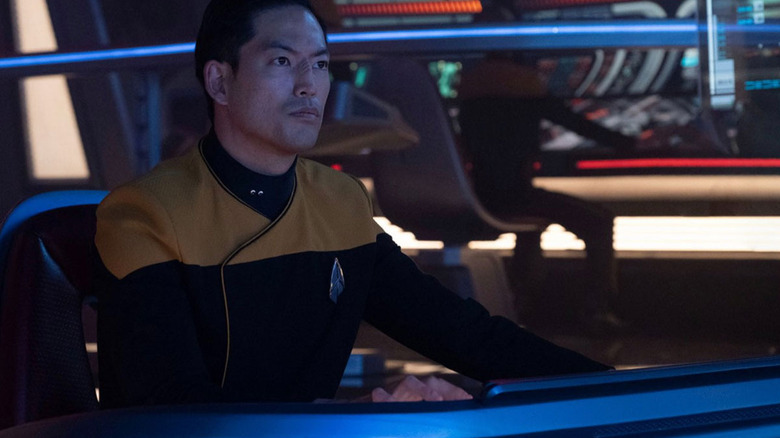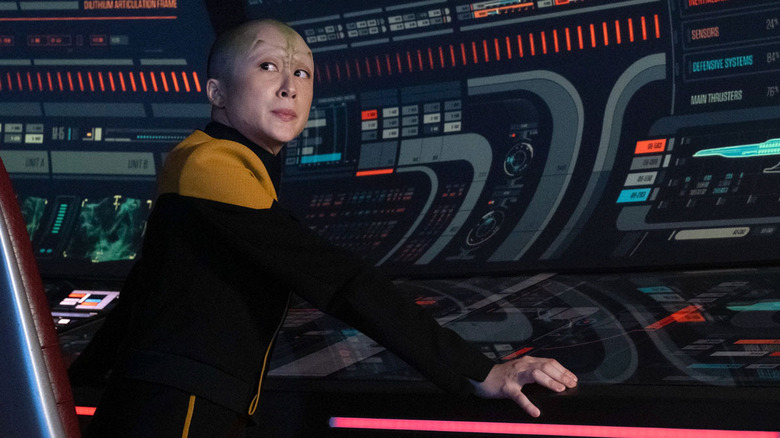The Alien-Centric Crew Of The Titan Is A Highlight Of Star Trek: Picard Season 3
This article contains mild spoilers for Star Trek: Picard" season 3.
One general complaint Trekkies may make about "Star Trek" in general is its geocentricity. Every single "Star Trek" series to date ("Star Trek: Prodigy" notwithstanding) has featured a human captain from Earth. And while each show usually features several alien/artificial characters in prominent roles, humans are still the overwhelming norm. Indeed, Starfleet Headquarters is located on Earth, the Federation was officially founded on Earth, and all Starfleet vessels are constructed at the Utopia Planitia shipyards orbiting Mars.
These creative decisions are understandable from a production perspective; all the people making "Star Trek" are indeed humans, and all its viewers are from Earth. The aliens and androids on "Star Trek" are meant to offer human viewers a fresh perspective on their own humanity, inviting us to look at our own foibles as a species from the perspective of a non-human outsider. Humans may have particular philosophies or values, but those are going to be challenged by the appearance of a Klingon or a Vulcan.
Of course, a large part of the appeal of the alien characters in "Trek" is finding yourself in them. How do you, dear viewer, relate to a Ferengi? Would you like to live as Changelings do? It's all very tantalizing to ponder.
It's been 57 years since "Star Trek" first debuted. One might venture to propose that Trekkies, now deeply intimate with the property's many alien cultures, don't necessarily need human characters to serve as their narrative bedrocks. Case in point: While "Star Trek: Picard" still features a human captain at its center (Todd Stashwick's Capt. Shaw commands the U.S.S. Titan-A), most of his crew appears to be aliens. It feels ... weirdly refreshing.
Who needs humans anyway?
Of course, the selling point of this third season of "Star Trek: Picard" has been a reunion of the mostly human main characters from "Star Trek: The Next Generation." On that show, only Worf (Michael Dorn) and Data (Brent Spiner) were non-human, and Counselor Troi (Marina Sirtis) was half-human. Also, the returning characters from the previous seasons of "Picard" are human; Raffi (Michelle Hurd) and Seven of Nine (Jeri Ryan) being the only survivors.
As such, the non-human crew of the U.S.S. Titan hasn't been assertively highlighted just yet. Indeed, one could be forgiven for not remembering some of their names. Here, then, is a miniature primer for the reader, prompted by showrunner Terry Matalas on his own Twitter account:
Meet Ensign Kova Rin Esmar. Haliian. Communications. They graduated at the top of their class and speak over 72 alien languages. pic.twitter.com/QFDFIdNTR7
— Terry Matalas (@TerryMatalas) February 4, 2023
The officer working the science station at the back of the bridge is named Lt. T'Veen, and is played by actor Stephanie Czajkowski. In several scenes, she has retained the usual cool of a Vulcan, and even suggests courses of action based on logic. At the ops station at the front of the bridge is a Bajoran officer named Lt. Matthew Arliss Mura, played by actor Joseph Lee. One can see his Bajoran earring (a symbol of his species' spiritual practices), although it doesn't seem to be the same dangling type of earring previously seen on Bajorans. At the Titan's communication station is Ens. Kova Rin Esmar, played by Jin Maley. A sharp-eyed Trekkie might notice Esmar's species to be the same as Aquiel (Renée Jones), a one-off character from "The Next Generation" who was Haliian. (Don't be embarrassed, Trekkies, if you couldn't remember Haliians right away. I, too, had to look it up.) Matalas also uses they/them pronouns describing Esmar, confirming them as non-binary just like Maley.
Around the ship
Additionally, the chief medical officer on board the U.S.S. Titan is a Trill named Dr. Ohk, and is played by Tiffany Shepis. The Trill are noted for their biological capacity for hosting a species of foot-sized worms that live inside their abdomens. The worms are incredibly long-lived, and can be passed from host to host over the course of centuries. When bonded, the worm and the host vaguely blend personalities and memories, allowing them to essentially live out multiple lives. It hasn't been said if Dr. Ohk has a symbiote, but we do know that she has a very curt bedside manner, and she berates Dr. Crusher (Gates McFadden) for not understanding a lot of the modern advances made in Starfleet medicine.
One of the most appealing aspects of "Star Trek" going back to its early days in the 1960s is its natural multiculturalism. The bridge of the U.S.S. Enterprise depicted a Black woman, an Asian-American man, a Russian man, and a male Vulcan all merely working together as a unit. It didn't take Trekkies too long to see "Star Trek" as an ensemble show, rather than a series focused on its three leads (William Shatner, DeForest Kelley, Leonard Nimoy). In 1987, "The Next Generation" was more pointedly and deliberately an ensemble series, and every character was given a voice. Best of all, "Star Trek: Deep Space Nine" eventually grew to include about 30 main characters, each of them with a point of view and a story arc.
While "Star Trek: Picard" focuses mainly on its title character and his old NextGen crew, Trekkies can see an interesting series taking place in the background.


